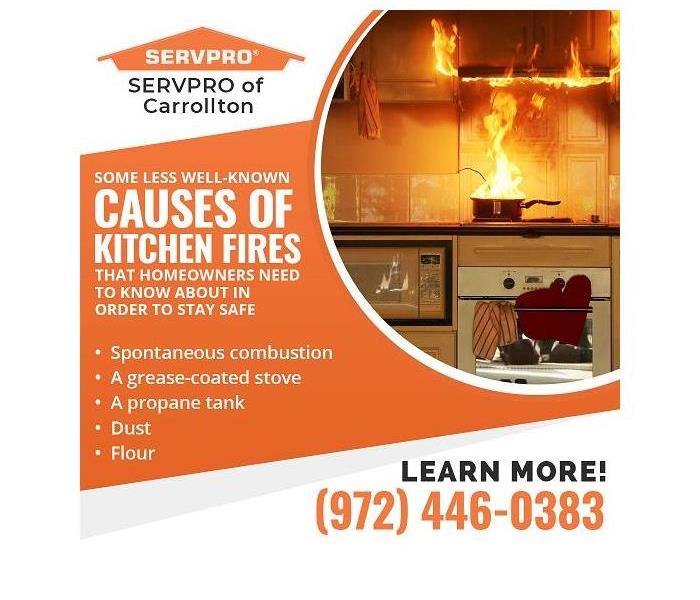Little Known Kitchen Hazards That Can Cause a Fire Damage Disaster
2/1/2022 (Permalink)
Blog Summary: SERVPRO of Carrollton highlights five kitchen fire damage risks that homeowners should know about.
SERVPRO of Carrollton confronts and overcomes the unique challenges and dangers presented by a fire damage cleanup and restoration project. On scene within an hour of the customer’s initial contact, the crew’s training and discipline take charge as they inspect and assess the situation and execute a well-coordinated cleanup and restoration plan. SERVPRO of Carrollton explains kitchen fire damage risks that the homeowner should know about. The goal is to prevent a fire damage disaster from ever happening.
According to the National Fire Protection Association, most house fires occur in the kitchen. This statistic reflects the activities that take place in this important room in the home. Appliances such as the oven, stovetop, microwave, crockpot, countertop grill, air fryer, deep fryer, coffeemaker, and toaster operate at temperatures high enough to ignite flammable materials found in the home. The food being cooked, the cook’s clothing, and the appliance itself can all catch fire, causing fire damage and potential injuries.
Listed below are some less well-known causes of kitchen fires that homeowners need to know about in order to stay safe.
#1. Spontaneous combustion
Certain chemicals in a material can react together, resulting in the generation of heat. The temperature may increase to the point where the material spontaneously combusts and bursts into flames. Spontaneous combustion can occur when items such as sawdust, compost, or oil-based products are stored improperly. For instance, if the internal heat created by a kitchen compost container is not allowed to escape, spontaneous combustion could occur. However, such cases are rare. Keep the compost pile turned and moist for the best results.
#2. A grease-coated stove
A clean stove is a safer stove. A stove coated with grease and other flammable grime presents a fire hazard that could allow a small kitchen fire to get out of control very quickly. Take a minute to wipe down the stove and the countertop near the stove. Clear the area around the stove.
Before turning on the heat, make sure napkins, paper plates, paper towels, dishcloths, and flammable cooking ingredients (cooking liquors such as bourbon, sherry, rum, etc.) are kept at a safe distance from the stove.
#3. A propane tank
A propane tank used for the grill should not be stored inside the home because the tank can leak when not in use. A small shed or storage closet in the garage is not the best and safest place to store a propane tank. If a small leak accumulates, it can ignite with a spark from an outlet or an arc when an appliance cycles on. The best place to store flammables is in a sheltered area located at a safe distance from the house or other detached structure. The flammables need to be protected from the elements and kept well-ventilated to prevent the ignition of leaked propane or fumes.
#4. Dust
Dusting is an important chore around the home, especially in the kitchen with so many heat sources. Most people think of dust bunnies as hiding under the bed, dresser, and sofa. In the kitchen, dust can create a hazardous situation involving fire risks. Dust bunnies can ignite if exposed to a spark from an electrical outlet. Regularly clean dust build-up, and remember to dust behind and under refrigerators and freezers. Also, clean under the oven, another favorite hiding place for dust bunnies.
#5. Flour
Flour can create a kitchen fire hazard. Air-born flour dust can combust under certain cooking conditions in the kitchen. Non-dairy creamer, dried milk, spices, and other powdered food substances can readily ignite in a cooking environment. The open flame from a gas oven or stovetop burner presents an elevated risk when these types of consumables are in use. The tiny dust particles burn very quickly and efficiently from all exposed sides. The dust particles have the potential to flare up much like gas fumes when exposed to an open flame.
A house fire creates a complex damage scene involving fire damage, smoke damage, and water damage. Combustion causes chemical reactions that make a fire scene very toxic for humans and pets. Cleanup and restoration require training, experience, special cleaning techniques and products, and personal protective gear (PPG).
The professionals at SERVPRO of Carrollton can clean, deodorize, and restore a fire-damaged property as if the fire had never occurred. A DIY fire damage restoration project is not advised.
Trust the restoration experts at SERVPRO of Carrollton for fire damage cleanup services in Dallas, TX. The company offers twenty-four-hour rapid emergency response, 365 days a year.
Contact the team at SERVPRO of Carrollton by phone at (972) 446-0383. The damage restoration company can also be contacted by email at office@SERVPRO10952.com

 24/7 Emergency Service
24/7 Emergency Service
